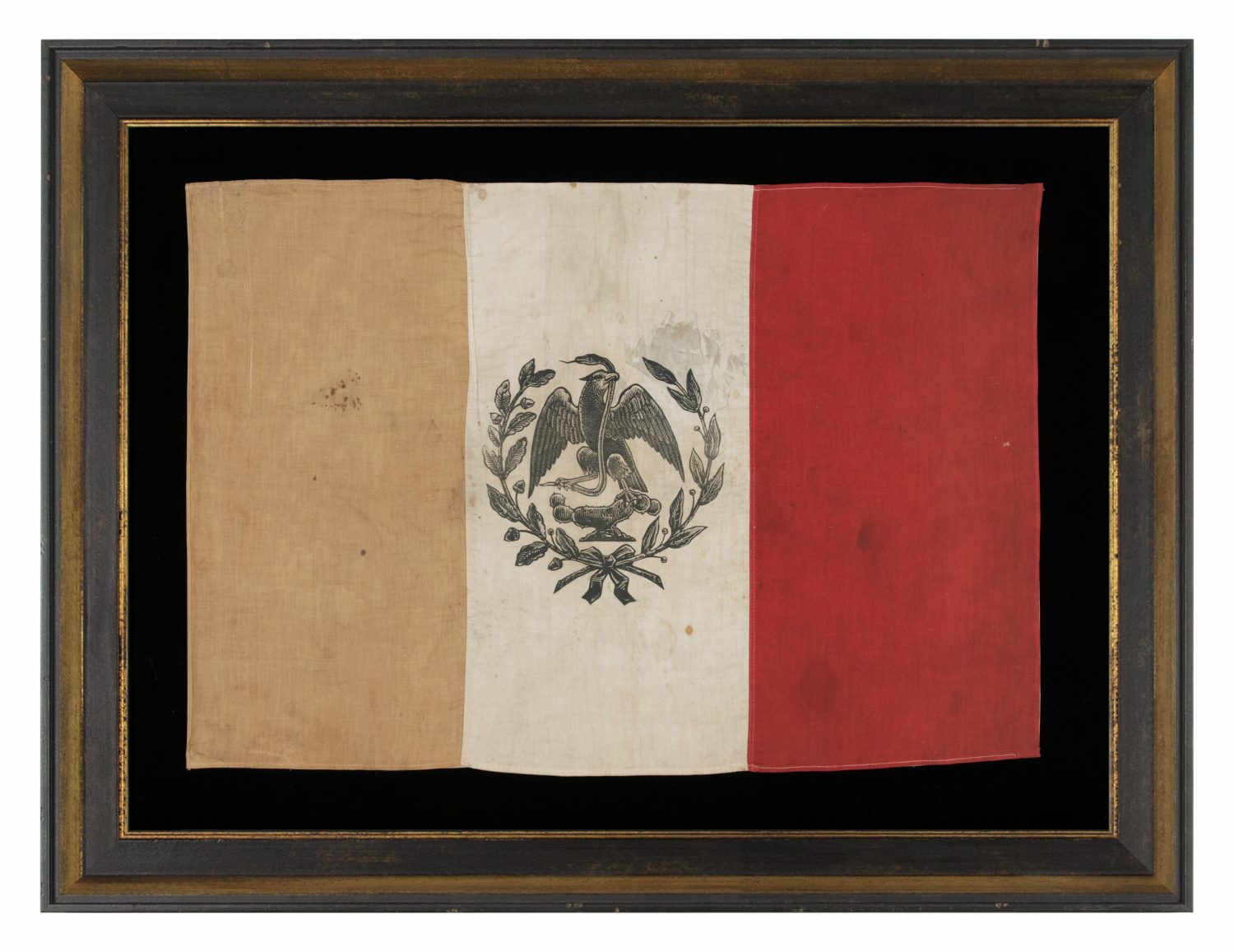
| |
FLAG OF MEXICO IN THE DESIGN USED BETWEEN 1893-1916 |
|
| Available: |
Sold |
| Frame Size (H x L): |
Approx. 34.5" x 45" |
| Flag Size (H x L): |
22.5" x 33" |
|
| Description....: |
|
Flag of Mexico in the design adopted in 1893 and official from that year until 1916. Probably made towards the latter end of this date span, during the era of Francisco "Poncho" Villa and the Mexican Revolution, the flag is constructed of three panels of cotton in green (faded to gold), white, and red, to create three vertical bars, with the charge on the center bar, printed in black. The device consists of an eagle, perched on a prickly pear (cactus), gripping a rattlesnake in one of its talons and beak. This is cradled within an open wreath of oak and laurel branches, tied at their juncture with a bow, striped with the national colors.
The bars of the flag are joined with machine stitching and the flag is then bound on three sides by the same method. The fly end bears the finished, selvedge edge of the red cotton.
At the end of the term of use of this design, in 1916, U.S. President Woodrow Wilson sent General John Pershing to capture Poncho Villa. The chase ended abruptly in 1917, when the U.S. entered WWI (U.S. involvement 1917-1918). It was in this year that the U.S. recognized the Carranza government of the Mexican Revolutionaries, in order to secure a status of Mexican neutrality in the World War. U.S. intervention was a direct consequence of the Zimmermann telegram, sent by Germany to Mexico, which proposed a military alliance in the event that the United States entered the war against Germany.
The design of the flag is very close to others that had been in use since 1821. The tri colors represent the armies of the Three Guarentees, which defeated Spain to secure Mexican independence. Bars representing these were originally set on the diagonal, in February of that year, the then turned upright in November. The eagle appeared at the same time, perched on the cactus and wearing a crown, with the cactus growing upright from a rock, emerging from a body of water. Variations of the eagle have been in use ever since, with the rattlesnake appearing in 1823. The original rattlesnake design was very similar to the one on the flag in question here. Used until 1829, then readopted from 1858-1862, and once again from 1867-1893, the primary difference between the first rattlesnake design and the one on the flag that is the subject of this narrative, is that the head of the snake, that droops below the eagle on the earlier device, as if dying, arches above it on the 1893-1916 version, as if fighting.
Condition: The dye used in the green cotton was fugitive and the color has turned to a golden tan. There is some staining and soiling throughout, but the device is attractive and the overall presentation is very nice. Many of my clients prefer early flags to show their age and history of use.
Mounting: The flag was mounted and framed within our own conservation department, which is led by masters degree trained staff. We take great care in the mounting and preservation of flags and have framed thousands of examples; more than anyone worldwide.
The background is 100% cotton twill, black in color. The black-painted, hand-gilded and distressed molding is Italian. The glazing is U.V. protective plexiglass. Feel free to contact us for more details. |
|
|
|
| Collector Level: |
Beginners and Holiday Gift Giving |
|
| Flag Type: |
Sewn flag |
|
| Star Count: |
|
|
| Earliest Date of Origin: |
1910 |
|
| Latest Date of Origin: |
1916 |
|
| State/Affiliation: |
Other |
|
| War Association: |
|
|
| Price: |
SOLD |
|
| |
Views: 2722 |
|
|
|

